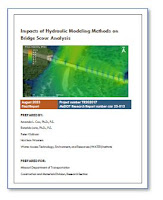This study has three primary purposes: 1) to investigate the impacts of hydraulic modeling methods on bridge scour analysis, 2) to develop recommendations for sediment/soil sampling methods, and 3) to conduct bridge scour risk assessments. Field data were collected at five study sites to obtain the required terrain and soil/sediment input data for hydraulic modeling and scour analyses. The recommended methods developed for soil/sediment sampling in the overbank areas are soil augers or test pits, and for overwater locations, a FISP or clamshell sampler is recommended. Contraction, abutment, and pier scour depths were computed using the HEC-18 guidelines with hydraulic conditions determined from a 1-D model (HEC-RAS) and a 2-D model (SRH-2D).Determining the required input parameters for scour calculations from HEC-RAS results was found to be difficult with many potential sources of human error. In contrast, the Hydraulic Toolbox program for scour calculations can auto-populate the required input parameters directly from SRH-2D output data. For all bridge sites evaluated, estimates for at least one of the main scour categories (i.e., channel contraction scour, pier scour, or abutment scour) were more than 50% different between the HEC-RAS 1-D and SRH-2D results. The key findings from comparing model results were: 1) the angle of attack was the dominant pier scour input parameter and 2) flow conveyance over inundated roadway embankments was significantly greater for SRH-2D relative to the HEC-RAS model. The 2-D modeling methods are recommended for future use given the significant differences observed between the 1-D and 2-D scour results, increased availability of terrain data, current computing resources, and ease of use. Finally, due to differences in the HEC-RAS and SRH-2D estimated scour depths, reanalyzing high-risk and/or visually vulnerable bridges is recommended.
Report number: cmr 23-013
Published: August 2023
Published: August 2023
Project number: TR202017
Authors: Amanda L. Cox, Ronaldo Luna, Peter Kickham, and Harrison Wooters
Authors: Amanda L. Cox, Ronaldo Luna, Peter Kickham, and Harrison Wooters
Performing organization: Water Access Technology, Environment, and Resources (WATER) Institute

No comments:
Post a Comment
Note: Only a member of this blog may post a comment.